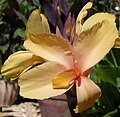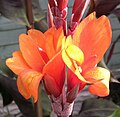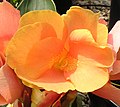This list of Canna cultivars is a gallery of named cultivars of plants in the genus Canna that are representative of the various Canna cultivar groups (i.e., groups of very similar cultivars).
Names of cultivars conform to the rules of the International Society for Horticultural Science (ISHS) Commission for Nomenclature and Cultivar Registration, as laid down in the International Code of Nomenclature for Cultivated Plants. They are registered with an International Cultivar Registration Authority (ICRA), which for the genus Canna is the Royal General Bulbgrowers' Association of the Netherlands (KAVB).
Foliage group
Cultivars, F1 and F2 hybrids, normally with small species-like flowers, but grown principally for their foliage. This group has occasionally been referred to as the Année Group, after the originator, Théodore Année, the world's first Canna hybridizer. However, the use of an accented character in the name creates problems, both in pronunciation and keyboard entry, that it was felt that as they were grown primarily for foliage, then "Foliage Group" was the better name choice.
-
 Canna 'Argentina', I. Cooke 1999
Canna 'Argentina', I. Cooke 1999
-
 Canna 'Auguste Ferrier'
Canna 'Auguste Ferrier'
-
 Canna (Agriculture Group) 'Edulis Dark'
Canna (Agriculture Group) 'Edulis Dark'
-
Canna 'Ferrandii'
-
 Canna 'Musaefolia Grande', H. Kelly Jnr.
Canna 'Musaefolia Grande', H. Kelly Jnr.
-
 Canna 'Intrigue'
Canna 'Intrigue'
-
 Canna 'Omega'
Canna 'Omega'
-
 Canna 'Russian Lance', Dalebö 2001
Canna 'Russian Lance', Dalebö 2001
-
 Canna × ehemannii
Canna × ehemannii
Crozy group
A cultivar group where the flower spikes are arranged close together on the stalk and have narrow to medium petals. There is always space between the staminodes when arranged formally, and the labellum (lip) is smaller than the staminodes, and is often twisted or curled.
The pioneer of this group was Monsieur Crozy of Lyons, France, who started breeding cannas as early as 1862, from stock originally developed by Théodore Année.
They are sometimes referred to as gladiolus flowering cannas, but describing flowers as similar to another genus is not encouraged. In the past, they were called the Canna × generalis L.H. Bailey garden species, but the use of nothospecies for complex garden hybrids have been replaced by Cultivar Groups in the International Code of Nomenclature for Cultivated Plants.
-
 Canna 'R. Wallace', Pfitzer 1902
Canna 'R. Wallace', Pfitzer 1902
-
Canna 'Anette Dalebö', Dalebö 2006
-
 Canna 'Antonin Crozy', Crozy
Canna 'Antonin Crozy', Crozy
-
 Canna 'Apricot Dream', K. Kelly
Canna 'Apricot Dream', K. Kelly
-
 Canna 'Florence Vaughan', Crozy 1892
Canna 'Florence Vaughan', Crozy 1892
-
 Canna 'Jessie Dalebö', Dalebö 2003
Canna 'Jessie Dalebö', Dalebö 2003
-
 Canna 'Königin Charlotte', Pfitzer 1893
Canna 'Königin Charlotte', Pfitzer 1893
-
 Canna 'Madame Crozy', Crozy 1890
Canna 'Madame Crozy', Crozy 1890
-
Canna 'Percy Lancaster', Sydney Percy-Lancaster
-
 Canna 'Pretty Butterfly', M. Sheppard
Canna 'Pretty Butterfly', M. Sheppard
-
 Canna 'Souvenir de Madame Nardy', Crozy
Canna 'Souvenir de Madame Nardy', Crozy
Italian group
A cultivar group with large, fragile staminodes. Flowers are arranged somewhat loosely, with wide petals, so wide that there is no space between them, when arranged formally. The labellum (lip) is larger, or at least as large, as the staminodes, unlike the other groups where it is smaller and sometimes curled. The stamen is also much wider than that in the other cultivar groups.
Also, used to be called the orchid flowering cannas, or C. × orchiodes L.H. Bailey garden species, although such "pretend" species are now deprecated in favour of Cultivar Groups. In any event, it is difficult to see the similarity between this group and orchids.
Most of this group obtained its larger sized flowers from the introduction of Canna flaccida in the early 1890s by Dr Sprenger in Naples, Italy followed shortly afterwards by Luther Burbank in California, United States, with the same cross.
-
Canna 'Allemania', Sprenger 1896
-
 Canna 'American Flag', Wintzer 1902
Canna 'American Flag', Wintzer 1902
-
Canna 'Austria', Sprenger 1893
-
Canna 'Bavaria', Sprenger 1895
-
 Canna 'Burbank', Burbank 1895
Canna 'Burbank', Burbank 1895
-
Canna 'Burgundia', Sprenger 1896
-
Canna 'Italia', Sprenger 1893
-
Canna 'Mrs Kate Gray'
-
Canna 'Parténope', Sprenger 1897
-
 Canna (Variegated Group) 'Phasion'
Canna (Variegated Group) 'Phasion'
-
Canna 'Roi Humbert'
-
Canna 'Roma', Sprenger 1896
-
 Canna (Variegated Group) 'Trinacria Variegata'
Canna (Variegated Group) 'Trinacria Variegata'
-
Canna 'Uncle Sam' Wintzer
-
 Canna 'Wyoming' Wintzer
Canna 'Wyoming' Wintzer
-
 Canna 'Yellow King Humbert' Burbank
Canna 'Yellow King Humbert' Burbank
Australian group
The result of a crossing of a Foliage Group seed parent with an Italian Group pollen parent (C. 'Red Stripe' x C. 'Bengal Tiger'), which resulted in the very large leaves of the Foliage Group allied with large flowers.
Premier group
This grouping contains cultivars that have a large, circular shape, without gaps between the staminodes when ordered. These are derived from triploids and crosses with the Italian Group cultivars.
-
 Canna 'Aida', Howard & Smith 1920s
Canna 'Aida', Howard & Smith 1920s
-
Canna 'Alfred Young', Dalebö 2005
-
 Canna 'Eureka'
Canna 'Eureka'
-
 Canna 'Karla Dalebö', Dalebö 2007
Canna 'Karla Dalebö', Dalebö 2007
-
 Canna 'Mary Layden', Dalebö 2005
Canna 'Mary Layden', Dalebö 2005
-
 Canna 'The President', Wintzer 1920
Canna 'The President', Wintzer 1920
Variegated group
Cultivars with variegated foliage, regardless of what other Group they may belong to.
-
 Canna (Italian Group) 'Bengal Tiger'
Canna (Italian Group) 'Bengal Tiger'
-
 Canna (Italian Group) 'Phasion'
Canna (Italian Group) 'Phasion'
-
 Canna (Italian Group) (Miniature Group) 'Pringle Bay', Bloch
Canna (Italian Group) (Miniature Group) 'Pringle Bay', Bloch
-
 Canna (Italian Group) 'Trinacria Variegata'
Canna (Italian Group) 'Trinacria Variegata'
Conservatory group
The growing conditions in a conservatory are quite specialised and do not suit many cultivars, this group have been selected for thriving in this environment, required features being plant vigor, early flowering, foliar appearance, self-cleaning ability and good propagation qualities. The originator of this group was Robert Armstrong (geneticist) while he was working at Longwood Gardens in the United States in 1967.
Aquatic group
Cultivars that thrive as marginal water plants. Characteristically, they will have lance-shaped foliage and long, thin rhizomes.
-
 Canna 'Endeavour', Armstrong
Canna 'Endeavour', Armstrong
-
 Canna 'Erebus', Armstrong
Canna 'Erebus', Armstrong
-
 Canna 'Erebus', Armstrong
Canna 'Erebus', Armstrong
-
 Canna 'Ra', Armstrong
Canna 'Ra', Armstrong
Miniature group
Cultivars growing under 0.5m (19") high, the flowers should be in scale to the rest of the plant.
Agriculture group
Cultivars grown selectively for agricultural usage, normally for their very large rhizomes and a high starch yield. See Canna Agriculture Group for more details.
-
 Canna 'Achira Dark'
Canna 'Achira Dark'
-
 Canna 'Queensland Arrowroot'
Canna 'Queensland Arrowroot'
Musaefolia Group
The Musaefolia Group, having large leaves and being either tall or giant in size consists of cultivars whose leaves resemble those of banana plants (genus Musa). Until this group was designated, the cultivars were considered to be members of the Foliage Group.
-
 Canna 'Musaefolia Hybrida'
Canna 'Musaefolia Hybrida'
-
Canna 'Musaefolia Hybrida'
-
 Canna 'Musaefolia Peruviana'
Canna 'Musaefolia Peruviana'
-
Canna 'Musaefolia Peruviana'
-
Canna 'Musaefolia Rubra'
-
 Canna 'Musaefolia Grande'
Canna 'Musaefolia Grande'
See also
References
- ^ Brickell, Christopher D. (January 2004). International Code of Nomenclature for Cultivated Plants (7th ed.). Lubrecht & Cramer Ltd. ISBN 90-6605-527-8.
- ^ Dalebö, Malcolm (April 24, 2007). "Canna cultivar groups". Canna News. Retrieved 2011-05-27.
- ^ Khoshoo, T.N.; Guha, I. (1976). "Origin and Evolution of Cultivated Cannas". New Delhi: Vikas Publishing House.
{{cite journal}}: Cite journal requires|journal=(help) - ^ Percy-Lancaster, Sydney (1927). An Amateur in an Indian Garden.
- ^ Dalebö, Malcolm (24 April 2007). "Comparison of Crozy and Italian Groups". Canna News. Retrieved 2011-05-27.
- Chaté, E. (1867). Le Canna, son histoire, sa culture (in French). Librairie Centrale d'Agriculture et de Jardinage.
- ^ Cooke, Ian (September 1, 2001). The Gardener's Guide to Growing Canna. Timber Press. ISBN 978-0-88192-513-5.
- Dalebö, Malcolm (October 6, 2008). "Australian Group". Canna News. Retrieved 2011-05-27.
- Dalebö, Malcolm (June 29, 2007). "Premier Group". Canna News. Retrieved 2011-05-27.
- ^ Armstrong], Robert. "Plant Introductions".
- Tanaka, N (2001). "Taxonomic revision of the family Cannaceae in the New World and Asia". Makinoa. 2nd (1): 34–43.
- Yang Fang; Wang PingHua; Xie ShiQing; Zhang WeiGuang; Fang DeHua (2004). "Technique of scarifying and fermenting process of Canna starch". 17 (2). Southwest China Journal of Agricultural Sciences: 231–234.
{{cite journal}}: Cite journal requires|journal=(help)
External links
- Claines Canna Collection Archived 2007-02-03 at the Wayback Machine
| Breeds and cultivars | |
|---|---|
| Methods | |
| Animal breeds | |
| Plant cultivars | |
| Selection methods and genetics | |
| Other | |






